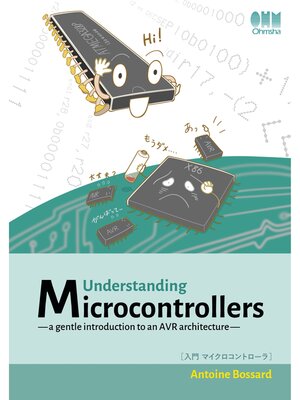Understanding Microcontrollers ―a gentle introduction to an AVR architecture―
ebook
By Antoine Bossard

Sign up to save your library
With an OverDrive account, you can save your favorite libraries for at-a-glance information about availability. Find out more about OverDrive accounts.
Find this title in Libby, the library reading app by OverDrive.



Search for a digital library with this title
Title found at these libraries:
| Library Name | Distance |
|---|---|
| Loading... |
※この商品はタブレットなど大きいディスプレイを備えた端末で読むことに適しています。また、文字だけを拡大することや、文字列のハイライト、検索、辞書の参照、引用などの機能が使用できません。
※この電子書籍は紙版書籍のページデザインで制作した固定レイアウトです。
本書は、「コンピュータアーキテクチャ」を履修する学生に向けた教科書として、マイクロコントローラを解説した英文書籍です。コンピュータの「特定化」や「省エネ」の社会を踏まえて、比較的わかりやすい機器「マイクロコントローラ」を用いてコンピュータアーキテクチャの基礎を解説しています。
なお、本書では、日本の学生の英語での学習を支援するために、本文中の重要キーワードについて適宜、日本語の訳や解説を側注に加えてることで英文原書の敷居を下げ、英語を敬遠する学生への導入書籍としても役立つ構成となっています。本書を読み進めれば、英文の読解力と情報関係の専門用語の知識を自然に得ることができ、今後、英語論文や英文原書を読みこなすための確かな力を身につけることができます。
List of Figures
List of Tables
List of Abbreviations
Preface
Chapter 1. Introduction
1.1 Motivation
1.2 About microcontrollers
1.3 Examples of microcontrollers and of their applications
Chapter 2. Preliminaries
2.1 Hardware
2.2 Software
2.3 Information representation
Chapter 3. Instruction Set Architecture
3.1 Instruction properties
3.2 Instruction set summary
3.3 Sample circuit implementation: ADD, ADC
Chapter 4. Memory Architecture
4.1 Preamble
4.2 The program memory space in flash
4.3 The data memory space in SRAM
4.4 The data memory space in EEPROM
4.5 What about the cache?
Chapter 5. Processor Architecture
5.1 Registers
5.2 The stack
5.3 Pipelining
Chapter 6. Addressing Modes
6.1 Direct register addressing
6.2 Direct memory addressing
6.3 Indirect memory addressing
6.4 Relative program memory addressing
Chapter 7. Programming the MCU
7.1 Arithmetic instructions
7.2 Logic instructions
7.3 Bit instructions
7.4 Data transfer instructions
7.5 Flow control instructions
7.6 System control instructions
7.7 Several useful features of the assembler
7.8 Basic program structure
Chapter 8. I/O Ports
8.1 Preamble
8.2 Accessing the pins of the ports B, C and D
Chapter 9. Interrupts
9.1 Preamble
9.2 Interrupt vectors
9.3 Basic program structure
9.4 Application: timer-counters
9.5 Application: the watchdog timer
9.6 Application: external interrupts
Chapter 10. Application: LCD Panel Control
10.1 Electrical setup
10.2 Wait subroutines
10.3 LCD control
Chapter 11. The Analog-to-Digital Converter
11.1 Presentation
11.2 Application: a photodetector
11.3 Application: a temperature sensor
Chapter 12. Communication Through the Serial Peripheral Interface
12.1 Presentation
12.2 Transmission synchronisation
12.3 Implementation
Chapter 13. Rational Numbers and the MCU
13.1 The fixed-point format
13.2 The floating-point format
Chapter 14. Reverse Engineering
14.1 Intel HEX format
14.2 Automatic disassembly of machine code
Chapter 15. Concluding Remarks
Appendix A. Character Codes
Appendix B. Logic Gates
Appendix C. Answers and Discussions
Bibliography
About the Author
Index
※この電子書籍は紙版書籍のページデザインで制作した固定レイアウトです。
本書は、「コンピュータアーキテクチャ」を履修する学生に向けた教科書として、マイクロコントローラを解説した英文書籍です。コンピュータの「特定化」や「省エネ」の社会を踏まえて、比較的わかりやすい機器「マイクロコントローラ」を用いてコンピュータアーキテクチャの基礎を解説しています。
なお、本書では、日本の学生の英語での学習を支援するために、本文中の重要キーワードについて適宜、日本語の訳や解説を側注に加えてることで英文原書の敷居を下げ、英語を敬遠する学生への導入書籍としても役立つ構成となっています。本書を読み進めれば、英文の読解力と情報関係の専門用語の知識を自然に得ることができ、今後、英語論文や英文原書を読みこなすための確かな力を身につけることができます。
List of Figures
List of Tables
List of Abbreviations
Preface
Chapter 1. Introduction
1.1 Motivation
1.2 About microcontrollers
1.3 Examples of microcontrollers and of their applications
Chapter 2. Preliminaries
2.1 Hardware
2.2 Software
2.3 Information representation
Chapter 3. Instruction Set Architecture
3.1 Instruction properties
3.2 Instruction set summary
3.3 Sample circuit implementation: ADD, ADC
Chapter 4. Memory Architecture
4.1 Preamble
4.2 The program memory space in flash
4.3 The data memory space in SRAM
4.4 The data memory space in EEPROM
4.5 What about the cache?
Chapter 5. Processor Architecture
5.1 Registers
5.2 The stack
5.3 Pipelining
Chapter 6. Addressing Modes
6.1 Direct register addressing
6.2 Direct memory addressing
6.3 Indirect memory addressing
6.4 Relative program memory addressing
Chapter 7. Programming the MCU
7.1 Arithmetic instructions
7.2 Logic instructions
7.3 Bit instructions
7.4 Data transfer instructions
7.5 Flow control instructions
7.6 System control instructions
7.7 Several useful features of the assembler
7.8 Basic program structure
Chapter 8. I/O Ports
8.1 Preamble
8.2 Accessing the pins of the ports B, C and D
Chapter 9. Interrupts
9.1 Preamble
9.2 Interrupt vectors
9.3 Basic program structure
9.4 Application: timer-counters
9.5 Application: the watchdog timer
9.6 Application: external interrupts
Chapter 10. Application: LCD Panel Control
10.1 Electrical setup
10.2 Wait subroutines
10.3 LCD control
Chapter 11. The Analog-to-Digital Converter
11.1 Presentation
11.2 Application: a photodetector
11.3 Application: a temperature sensor
Chapter 12. Communication Through the Serial Peripheral Interface
12.1 Presentation
12.2 Transmission synchronisation
12.3 Implementation
Chapter 13. Rational Numbers and the MCU
13.1 The fixed-point format
13.2 The floating-point format
Chapter 14. Reverse Engineering
14.1 Intel HEX format
14.2 Automatic disassembly of machine code
Chapter 15. Concluding Remarks
Appendix A. Character Codes
Appendix B. Logic Gates
Appendix C. Answers and Discussions
Bibliography
About the Author
Index







